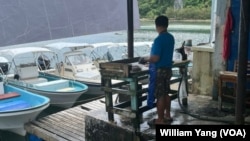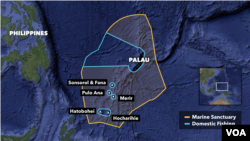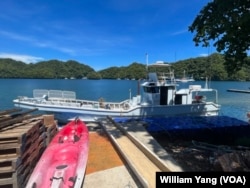When Palau passed a law to close off 80% of its oceans to fishing in 2015, the tiny pacific nation became a global leader in conservation. Palau’s national marine sanctuary is one of the largest in the world.
But now, that legacy is being tested with a government proposed plan to expand fishing in the waters from 20% to 50%.
The debate over the plan is one key issue dividing voters in this year’s general elections, which take place next month on November 5.
The two presidential candidates in the election, current president Surangel Whipps Jr. and former president Tommy Remengesau Jr., who happen to be brothers-in-laws, hold opposing views over the future of the marine sanctuary.
Whipps Jr. believes Palau should try to strike a balance between ocean conservation and sustainable use of its marine resources, while Remengesau Jr. wants to see Palau remain a leader when it comes to ocean conservation.
The government’s proposed plan, officially titled Marine Spatial Planning, aims to continue Palau’s efforts to protect biodiversity in its territorial waters while trying to grow the Pacific Island country’s domestic fishing industry. The island’s fishing industry is small due to a lack of resources and fierce competition from foreign fishing vessels.
“We are trying to figure out how to protect and manage a healthy ocean while developing sustainable use of its resources,” Steven Victor, Palau’s Minister of Agriculture, Fisheries and Environment, told VOA in an interview from his office in Palau that faces the ocean and is near a popular fishing spot.
“If we are able to demonstrate that we can do it in Palau, it will have a wide-ranging impact on ocean conservation throughout the Pacific,” he added.
Victor said a drop in tuna supply in Palau and the country’s growing reliance on imported seafood is one of the key drivers behind the plan.
“We’ve seen an increase in seafood imports since 2020 because of the drop in local tuna supply and this has made fish unaffordable to the most vulnerable members in Palau,” he told VOA.
Rising tuna prices
The ban on any form of fishing in 80% of Palau’s Exclusive Economic Zone, or EEZ, has led to an increased catching and consumption of reef fish in Palau, which are species the sanctuary was meant to protect.
“When tuna at the local market in Palau is more expensive than reef fish, it leads to more consumption of reef fish, and it could affect tourism in the country since tourists come to Palau to see the reef fish,” Palau’s president Surangel Whipps Jr. told VOA in an interview at his office in Palau.
“As a leader in conservation, Palau should show how we can balance protection and production and it starts with using good science and doing a marine spatial plan,” he added.
While the Palauan government vows to balance conservation and sustainable exploration of the country’s marine resources through the proposed plan, some activists and politicians worry the proposal could damage Palau’s reputation as a leader in ocean conservation.
“Our reputation will be out of the door and there will be no more ‘pristine paradise Palau. This is a brand equity question I’ve brought up repeatedly,” said Jennifer Koskelin-Gibbons, co-founder of the Palau Legacy Project, an NGO that focuses on environmental protection and ocean conservation in Palau.
Others say the government’s attempt to expand the fishing zone in the marine sanctuary could cause Palau to lose valuable foreign funding for its conservation efforts.
“There is still the potential of getting funding through carbon credits, science, and efforts to address climate change so why are we lessening our contribution to the world,” Tommy Remengesau Jr., Palau’s former president who signed the marine sanctuary into law in 2015, told VOA in an interview at his home in Palau.
In response, Whipps Jr. said through the proposed plan, Palau is trying to do more than some scientific studies have suggested to ensure the biodiversity in its ocean remains protected.
“National Geographic released a report in May recommending that Palau should impose a 50-mile ban around all the reefs, which equates to a little less than 30 percent of our EEZ, to ensure biodiversity continues, and we say we’ll take a baby step by adjusting the marine sanctuary to 50% of Palau’s EEZ,” he told VOA.
Foreign fishing fleets
Some Palauan fishermen worry that the increased area for commercial fishing would allow big foreign fishing fleets to return to Palau and re-establish dominance over the fishing sector.
“Palau used to only get four percent out of 100 dollars through the license fee when foreign companies were allowed to fish in Palauan waters in the past, and I worry the government’s proposed plan would eventually bring back these foreign fishing companies, who will take all the fish away from Palauans,” Okada Techitong, the chairperson of Belau Offshore Fishers Inc, one of the two main local fishing companies in Palau, told VOA at his office.
Victor, Palau’s fisheries minister said the government plans to only allow fishing companies that have fished in Palauan waters since January 2020, which was when the marine sanctuary came into effect, to fish in the expanded fishing zone.
This means only two domestic fishing companies, Belau Offishore Fishers Inc. and Palau Commercial Fishing Company, as well as the Japanese fishing fleets helping to support Palau’s fishing industry, would be allowed to fish under the government’s proposed plan for the next five years.
“This could keep foreign fishing companies from coming in and re-establishing themselves in Palau and we feel that five years would be enough time for Palauan fishing companies to grow financially,” Victor told VOA.
However, some Palauan fishermen still think Palau should keep the marine sanctuary at the same size since the 20% fishing zone is already enough for the Palauan fishermen.
“Fishing is not an industry that a lot of Palauans are interested in joining, so I don’t think it’ll be easy for Palau to grow its own fishing industry,” Richard Rechirei, a Palauan fisherman told VOA at a ship repair shop in Palau.
As Palau’s senate reviews the government’s proposal, Victor said there is some opposition to the proposed plan in the senate. And with some environmental activists seeking election, the changes to the marine sanctuary could face some challenges after next month’s vote.
In order for all sides to reach a consensus on this “divisive issue,” Victor said trust needs to be established between the local community and the government in order for the plan to serve its purpose.
“If there’s no trust, this thing can’t work. The government hopes to provide relevant information so people can make informed decisions about how Palau should address this issue,” he told VOA.









